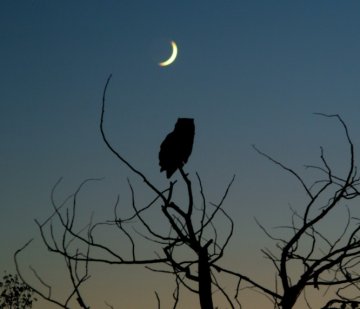 Would you like a call the next time a geomagnetic storm erupts? Sign up for Spaceweather PHONE.
Would you like a call the next time a geomagnetic storm erupts? Sign up for Spaceweather PHONE.
AURORA WATCH: A high-speed solar wind stream hit Earth last night, sparking auroras over parts of Canada and some northern US states: gallery. The storm has subsided, but the solar wind is still blowing, raising the possibility of another storm tonight. Sky watchers should remain alert for auroras.
LUNAR IMPACTS: There's a meteor shower on the Moon tonight. Like Earth, the Moon is inside the Delta Aquarid meteoroid stream. Unlike Earth, however, the Moon has no atmosphere to shield it. Meteors on the Moon hit the ground and explode. (continued below)

"Keeping an eye on the Moon." Photo credit: Jimmy Westlake. July 27, 2006.
Some of the impact flashes might be visible from Earth. When the sun goes down tonight, train your telescope on the crescent Moon: sky map. Look left of the crescent where the lunar terrain is dark. Split-second flashes of light could signal Delta Aquarids hitting the ground. Amateur astronomers who wish to make scientifically meaningful observations, please click here for tips.
WHAT'S ON TOP? On July 22nd, "my wife kindly blocked out the sun, revealing a beautiful sun halo criss-crossed by contrails," says photographer Charlie Szabototh of Wiarton, Ontario. The question is, what's on top? The halo or the contrails? Look carefully at the image, then scroll down for the answer:

The contrails are on top. See the dark fringes to the left of the contrails? Those are contrail shadows, cast down on the icy cloud layer that makes the sun halo. "I always find contrail shadows counter-intuitive," notes atmospheric optics expert Les Cowley. "Somehow we expect objects we see in the air to be in front of the clouds. These bright contrails, however, are not beneath the clouds; they are above them as their shadows reveal."
more images: from Bruno Nolf of Otegem, Belgium; from Dave Yates of Bishton, South Wales; from Riccardo Di Nasso of Pisa, Italy; from Laurent Laveder of Bretagne, France; from Martin Mc Kenna of Northern Ireland; from Rodrigo Roesch of Zion, Illinois;

